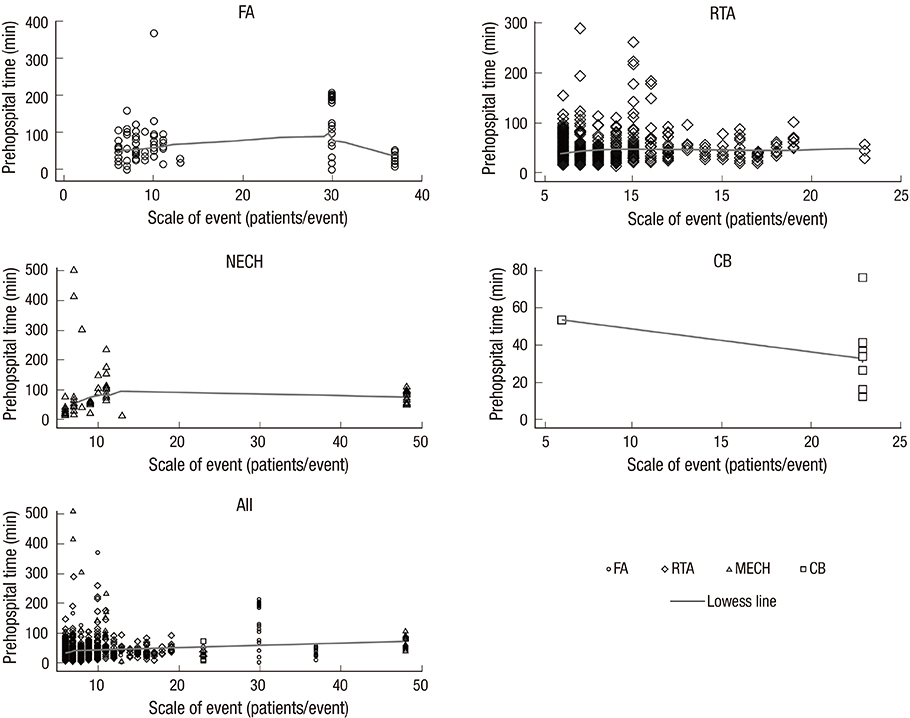J Korean Med Sci.
2016 Mar;31(3):449-456. 10.3346/jkms.2016.31.3.449.
Epidemiology of Emergency Medical Services-Assessed Mass Casualty Incidents according to Causes
- Affiliations
-
- 1Department of Emergency Medicine, Hallym University College of Medicine and Dongtan Sacred Heart Hospital, Hwaseong, Korea. juok.park@gmail.com
- 2Department of Emergency Medicine, Seoul National University College of Medicine, Seoul, Korea.
- 3Laboratory of Emergency Medical Service, Seoul National University Hospital Biomedical Research Institute, Seoul, Korea.
- KMID: 2363508
- DOI: http://doi.org/10.3346/jkms.2016.31.3.449
Abstract
- To effectively mitigate and reduce the burden of mass casualty incidents (MCIs), preparedness measures should be based on MCIs' epidemiological characteristics. This study aimed to describe the epidemiological characteristics and outcomes of emergency medical services (EMS)-assessed MCIs from multiple areas according to cause. Therefore, we extracted the records of all MCIs that involved > or = 6 patients from an EMS database. All patients involved in EMS-assessed MCIs from six areas were eligible for this study, and their prehospital and hospital records were reviewed for a 1-year period. The EMS-assessed MCIs were categorized as being caused by fire accidents (FAs), road traffic accidents (RTAs), chemical and biological agents (CBs), and other mechanical causes (MECHs). A total of 362 EMS-assessed MCIs were identified, with a crude incidence rate of 0.6-5.0/100,000 population. Among these MCIs, 322 were caused by RTAs. The MCIs involved 2,578 patients, and 54.3% of these patients were women. We observed that the most common mechanism of injury varied according to MCI cause, and that a higher number of patients per incident was associated with a longer prehospital time. The highest hospital admission rate was observed for CBs (16 patients, 55.2%), and most patients in RTAs and MECHs experienced non-severe injuries. The total number of deaths was 32 (1.2%). An EMS-assessed MCI database was established using the EMS database and medical records review. Our findings indicate that RTA MCIs create a burden on EMS and emergency department resources, although CB MCIs create a burden on hospitals' resources.
MeSH Terms
-
Accidents, Traffic/statistics & numerical data
Adolescent
Adult
Aged
Aged, 80 and over
Biohazard Release/statistics & numerical data
Chemical Hazard Release/statistics & numerical data
Child
Child, Preschool
Cross-Sectional Studies
Databases, Factual
*Emergency Medical Services
Female
Hospitals
Humans
Infant
Infant, Newborn
Male
Mass Casualty Incidents/*statistics & numerical data
Middle Aged
Retrospective Studies
Young Adult
Figure
Cited by 2 articles
-
Epidemiologic Characteristics of Injured School-age Patients Transported via Emergency Medical Services in Korea
Hang A Park, Ki Ok Ahn, Ju Ok Park, Jungeun Kim, Seungmin Jeong, Meesook Kim
J Korean Med Sci. 2018;33(10):. doi: 10.3346/jkms.2018.33.e73.Surge Capacity and Mass Casualty Incidents Preparedness of Emergency Departments in a Metropolitan City: a Regional Survey Study
SungJoon Park, Joo Jeong, Kyoung Jun Song, Young-Hoon Yoon, Jaehoon Oh, Eui Jung Lee, Ki Jeong Hong, Jae Hee Lee
J Korean Med Sci. 2021;36(33):e210. doi: 10.3346/jkms.2021.36.e210.
Reference
-
1. Kuisma M, Hiltunen T, Määttä T, Puolakka J, Boyd J, Nousila-Wiik M, Hakala T. Analysis of multiple casualty incidents - a prospective cohort study. Acta Anaesthesiol Scand. 2005; 49:1527–1533.2. Schenk E, Wijetunge G, Mann NC, Lerner EB, Longthorne A, Dawson D. Epidemiology of mass casualty incidents in the United States. Prehosp Emerg Care. 2014; 18:408–416.3. Branas CC, Sing RF, Perron AD. A case series analysis of mass casualty incidents. Prehosp Emerg Care. 2000; 4:299–304.4. Doyle CJ. Mass casualty incident. Integration with prehospital care. Emerg Med Clin North Am. 1990; 8:163–175.5. Kim CH, Park JO, Park CB, Kim SC, Kim SJ, Hong KJ. Scientific framework for research on disaster and mass casualty incident in Korea: building consensus using Delphi method. J Korean Med Sci. 2014; 29:122–128.6. Lauritsen EJ, editor. EpiData data entry, data management and basic statistical analysis system. Odense: EpiData Association;2000-2008.7. Landman A, Teich JM, Pruitt P, Moore SE, Theriault J, Dorisca E, Harris S, Crim H, Lurie N, Goralnick E. The Boston Marathon bombings mass casualty incident: one emergency department’s information systems challenges and opportunities. Ann Emerg Med. 2015; 66:51–59.8. El Sayed M, Tamim H, Mann NC. Description of procedures performed on patients by emergency medical services during mass casualty incidents in the United States. Am J Emerg Med. 2015; 33:1030–1036.
- Full Text Links
- Actions
-
Cited
- CITED
-
- Close
- Share
- Similar articles
-
- Characteristics of mass casualty chemical incidents: a case series
- Emergency Medical Services in Disasters
- Incidence and Mortality Rates of Disasters and Mass Casualty Incidents in Korea: A Population-Based Cross-Sectional Study, 2000-2009
- Hospital Triage System in Mass Casualty Incident
- Disaster Medical Assistance Team


